
During our sleepless nights, we often find ourselves contemplating the infiniteness of the universe. Is it truly boundless? And if it is, how can such boundlessness exist? How can space stretch endlessly without any end in sight? Or, perhaps, there is a certain limit to it? And if there is, what lies beyond that limit?
Usually, these ponderings yield no concrete answers. Instead, our minds gradually succumb to sleep as we gaze at the patterns on the rug adorning the wall. These patterns transform into spinning galaxies, illuminating the expanse of infinite space… 😊
Out of all the scientific inquiries that may cross your mind, the question regarding the boundlessness of the universe is undeniably one of the most challenging. Currently, there is no definitive answer to this question. Scientists propose that both possibilities are valid, and each perspective has its proponents and adversaries.
The process of determining the veracity of whether the Universe possesses any limitations ultimately relies on comprehending its structure and dimensions, as well as the portion of the cosmos we are able to observe in actuality.
What is the shape of the Universe?
Determining the true shape of the Universe is crucial in understanding its actual size. Cosmologists propose that the Universe could have one of three possible shapes, which are determined by the curvature of space.
According to some scientists, the Universe could be flat, meaning it has no curvature and is infinite. Alternatively, it could be open and saddle-shaped, with negative curvature, also infinite.
Lastly, the most comprehensible option for our limited three-dimensional minds is that the Universe is closed. It may resemble a four-dimensional sphere and be finite in size.
So, what is the true shape of the universe? John Mather, a Nobel Prize-winning cosmologist from NASA’s Goddard Space Flight Center, recently shared his perspective on the matter. According to Mather, the observations of the cosmic microwave background radiation (CMB), which is the residual radiation from the Big Bang, suggest that the universe is flat. In other words, it lacks any curvature within the observable space.
“Imagine an infinite piece of paper, that’s how flat the universe is,” Mather explained. “You can keep moving in any direction for an infinite amount of time, and the universe will remain the same. It is essentially homogenous.”
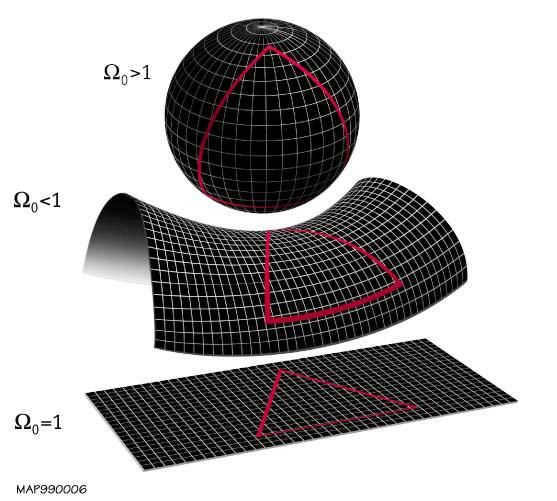
Calculating the dimensions of the universe
According to current calculations, the observable universe has a span of 46.5 billion light-years in every direction, with a diameter of 93 billion light-years.
What is the reason for this? The universe is 13.8 billion years old! However, there is an interesting detail. It took 13.8 billion light-years for light to travel from the farthest edge of the observable universe to reach our eyes. But since the occurrence of the Big Bang, the universe has continued to expand at an accelerating rate. In fact, in the most remote areas, it has surpassed the speed of light. As a result, the edge of the observable universe has moved significantly far away from us, currently measuring 46.5 billion light-years in distance.
According to different estimates, this immense expanse encompasses anywhere from 200 billion to 2 trillion galaxies. And within each of these galaxies exists, on average, at least 100 billion stars.
These colossal figures are simply beyond comprehension. However, how do scientists go about determining all of this?
They accomplish this through the use of various tools and techniques known as the “cosmic distance ladder.” They begin with distances that can be directly measured. One example is when radio waves bounce off nearby objects in the solar system. To do this, the time it takes for these radio waves to return to Earth is measured. Since the speed of radio waves is known, the distance they have traveled can be calculated based on their delay time.
When it comes to measuring distances that are more challenging, such as galaxies located at the far reaches of the universe, astronomers rely on calculations and observational data to make inferences.
For instance, a technique called the “parallax measurement” method is used. This method involves measuring the displacement of a star relative to objects in its background. Additionally, information about the “main sequence” is utilized, which encompasses our understanding of star evolution and their luminosity class. Understanding the relationship between a star’s brightness and its distance is crucial for pinpointing extremely distant objects. The analysis of redshift also plays a significant role, as it involves measuring changes in the wavelengths of light emitted by galaxies situated far away.
What is the Mystery of the Unseen Universe?
As we examine the information provided, it becomes evident that all the data and statistics mentioned pertain solely to the observable portion of the Universe. This refers to the spherical expanse of space that can be viewed from our vantage point on Earth or detected through the use of space telescopes and probes. However, what about the vast regions of the Universe that we are unable to perceive? It is conceivable that certain areas lie beyond our reach, their distance from us so immense that the light emitted since the inception of the Universe has yet to reach our planet!
Remarkably, a team of British scientists conducted a study that revealed the true size of the Universe could potentially be 250 times larger than what we currently observe. Through their calculations, the researchers concluded that a closed and finite Universe would encompass approximately 250 to 400 volumes exceeding the portion we are able to witness.
One alternative theory, proposed by scientists like Nobel Prize laureate Roger Penrose, suggests that the Big Bang was merely a single event in the ongoing cosmic evolution of our Universe. It is possible that there have been multiple instances of Big Bangs, followed by what are known as Big Compressions. These periods involve the Universe ceasing its expansion and collapsing, only to explode once more.
However, is the universe finite? Or is it a continuously expanding sphere with a “boundary”? Is there a specific location in space where one can walk to, look down, and exclaim, “Ah, there it is, the end of the universe! There is nothing beyond this point!”.
It is highly unlikely that this is the case.
Robert McNeice, an associate professor of physics at the University of Chicago, argues that the universe is isotropic, meaning it adheres to the “cosmological principle.” This principle states that the universe possesses the same properties and follows the same laws of physics in all directions.
If this statement holds true, then the Universe bears a striking resemblance to the surface of a balloon. Just picture yourself as an ant, diligently making your way across the expanse of the balloon. If you were to keep crawling incessantly, you wouldn’t perceive much change. Eventually, you would likely find yourself back at your starting point. However, unless you left behind any discernible clues, you wouldn’t even realize it. And so, this cyclical journey could continue indefinitely…
Nevertheless, imagine for a moment that someone were to inflate the balloon while you continued your diligent crawl. You would undoubtedly sense certain areas of the balloon expanding and moving apart. Intriguing, isn’t it?
But all things considered, it’s inconsequential. After all, you would never encounter the boundary of your balloon, no matter how long you traversed it.
Similarly, like ants, we are highly unlikely to reach the end of the universe. However, perhaps one day we will possess the ability to answer a fundamental question – is the universe truly infinite? Or does it possess some tangible boundary?
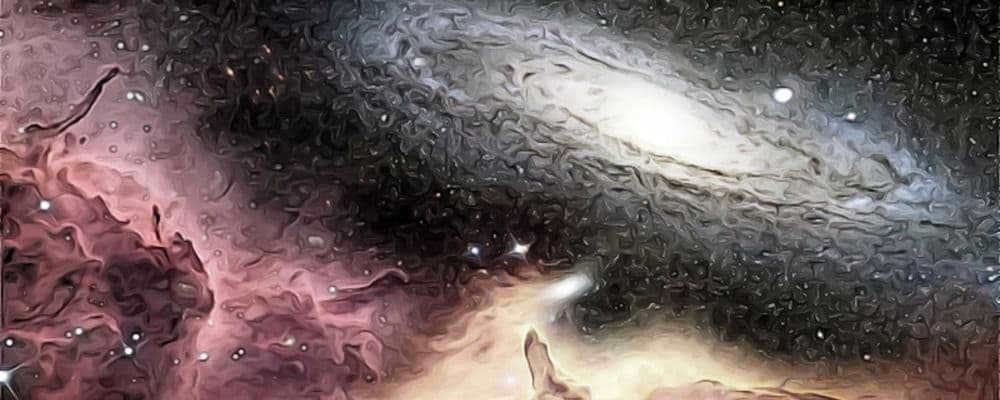
Individuals who enjoy science fiction films face a significant challenge when it comes to their perception of reality. They possess a distorted belief that our forthcoming technological advancements will be so advanced that interstellar travel will become effortless. They hold this conviction without a shadow of a doubt. Among these misguided individuals is myself, who firmly believes that the exploration of space is an unavoidable fate;
Our cosmos is immense.
However, none of these individuals possess any comprehension of the magnitude of their predicament. In the grand scheme of things, the cosmos is astonishingly expansive. Even the gaps between the closest celestial bodies are mind-boggling. And the vast distances found within our very own Milky Way Galaxy, not to mention those separating other galaxies, are simply astronomical! This is particularly true for sentient beings confined to a minuscule particle of dust orbiting an unexceptional star.
The theory of the Big Bang suggests that the universe was once incredibly small. The speed of light, which is approximately 300,000 kilometers per second, is the maximum speed at which radiation or any form of information can travel. It is widely accepted among scientists that the universe is approximately 13.8 billion years old. Therefore, over the course of nearly 14 billion years, the universe must have expanded to a size of about 30 billion light years across. Does this concept seem logical? Yes, it does. However, it is incorrect.
The Big Bang was not comparable to the explosion of a clapper on a Christmas tree in the Kremlin. Instead, after the Big Bang occurred, space-time itself began to expand simultaneously at all points simultaneously.
Constantly Growing!
As the expansion of the universe commenced, every 1 centimeter of “empty space” gradually doubled in size. First 2 centimeters, then 4, then 8, and so on. Currently, considering its expansion, the Universe measures approximately 46 billion light years in size. Consequently, the universe’s diameter amounts to about 93 billion light years.
However, there is a crucial caveat. This measurement pertains solely to the observable portion of the Universe, the part that is visible from Earth. According to the inflation theory, which enjoys substantial support among cosmologists, the visible universe does not encompass the entirety of the cosmos. In fact, some cosmologists even propose that the Universe is infinite in its entirety!
Now, let’s proceed with our thought experiment on scaling space distances. And let’s make another attempt to grasp the physical magnitude of not just our solar system, but also our tiny realm of existence. To gain a better understanding of our immediate environment, envision a scaled-down version of the solar system, where the Sun is placed in the center and each centimeter of space represents the distance between our star and Earth. This particular distance is referred to as an astronomical unit (AU). In other words, 1 AU is equivalent to 1 centimeter. For visual clarity, you can even sketch this out on a piece of paper.
Distances in the solar system
Therefore, the Sun is approximately 1 centimeter away from the Earth. Mercury and Venus are located at distances of 0.4 centimeters and 0.7 centimeters from the Sun, respectively. Beyond the Earth’s orbit, we find Mars at a distance of 1.5 centimeters. The main belt asteroids are positioned around 2.5 centimeters away from the Sun. Jupiter is situated 5 centimeters from our star. Saturn can be found at a distance of 9.5 centimeters. Uranus is located 19 centimeters away, while Neptune is positioned 30 centimeters from our star. For those who still support Pluto as a planet, it can be placed at a distance of 40 centimeters 😉.
The outer part of the solar system is characterized by a lack of material. It includes the Kuiper belt, which is situated 30 to 50 centimeters away from the Sun. Haumea is positioned at 40 centimeters, Makemake at -45, and Erida at 60. To complete our model, we can now define a region called the scattered disk, which consists of icy asteroids that are energetically moving between 50 and 100 centimeters from the Sun.
So, within a 1-meter radius, we have a comprehensive representation of the entire solar system.
Let’s consider this: at this scale, the inner edge of the Oort Cloud (a massive sphere containing 2 trillion comets!) would start at a distance of 100 meters from the Sun and extend up to one kilometer. It’s important to note that the Oort Cloud is also considered part of the solar system!
When you next discover yourself beneath the celestial bodies, make certain to lift your gaze. And contemplate deeply the magnitude of the Universe.
Indeed, its immense expanse elicits one of the most profound emotions a person can experience – a sense of pure enchantment! And simultaneously, the recognition of one’s own minuteness 😀.
Just how vast is the region of the Universe that we can perceive? Let us contemplate the extent to which we can peer into the cosmos.
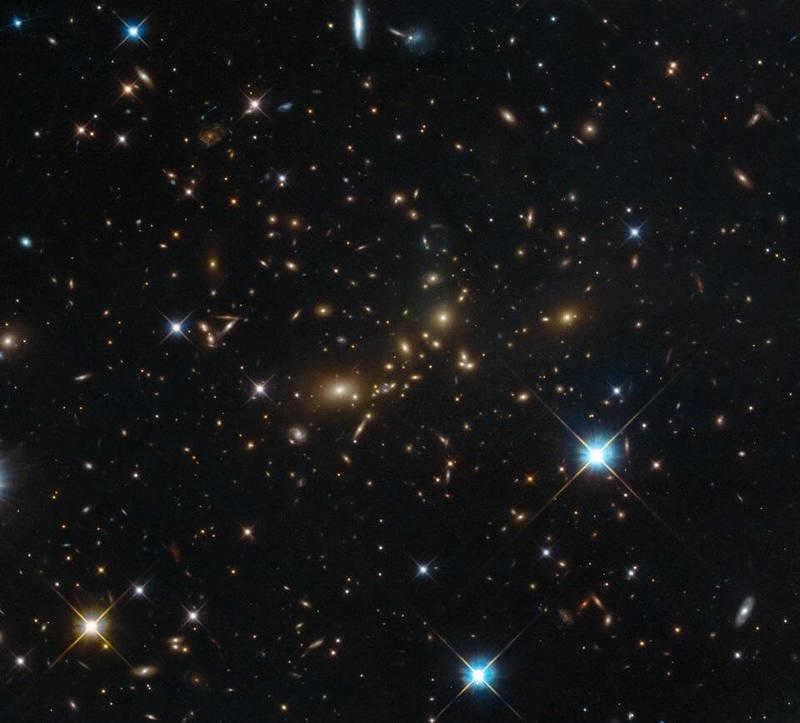
A striking visual captured by the Hubble Telescope showcases the extraordinary brilliance of PLCK_G308.3-20.2, a colossal galaxy cluster residing in the abyss of the cosmos. This captivating snapshot resembles countless remote corners of the Universe. Nevertheless, the true scope of the observable Universe, encompassing even the hidden realms, remains an enigma.
Approximately 13.8 billion years ago, an event known as the Big Bang set the stage for the cosmic narrative. At that moment, the Universe was brimming with matter, antimatter, and radiation, existing in a scorching and compressed state. Over time, it expanded and cooled, paving the way for the wonders we witness today.
How the universe appears
As of now, the universe we can observe has expanded to a radius of 46 billion light years, and the light that is reaching us has reached the maximum limit of our ability to measure. However, what lies beyond this boundary? What can we say about the parts of the universe that are beyond our observation?
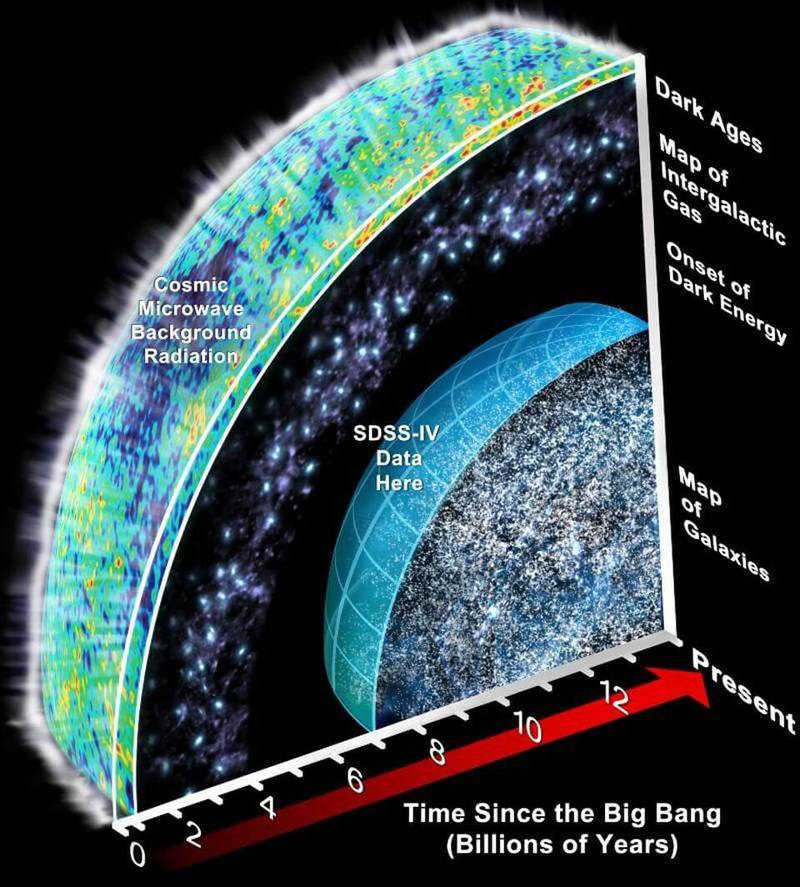
The history of the universe is defined as far back in time as we can observe using our various instruments and telescopes. However, it’s important to note that our observations can only provide information about the parts of the universe that are observable. Anything beyond that is purely speculative and relies on underlying assumptions.
At present, the Universe is both cold and uneven, and it is also expanding and influenced by gravity. When we observe objects in the far reaches of space, we are not only seeing them at great distances, but we are also looking back in time due to the finite speed of light.
Distant regions of the cosmos exhibit a greater degree of uniformity and lack irregularities due to the shorter timeframe for the formation of larger, intricate structures influenced by gravitational forces.
Furthermore, the early Universe, located at a great distance, possessed higher temperatures. The expansion of the Universe results in the elongation of light waves as they traverse through it. Consequently, light loses energy and cools. This implies that the Universe was hotter in its remote history, a verifiable truth that we have substantiated through the examination of the characteristics of far-flung sectors of the Universe.
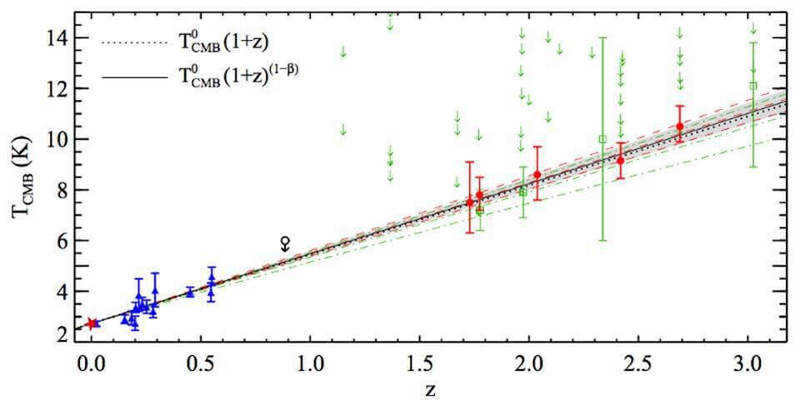
A 2011 study (represented by red dots) presents the most compelling evidence thus far that the temperature of relic radiation was higher in the past. The characteristics of light from distant sources confirm the expansion of space that we currently inhabit.
Investigation
By examining the radiation left over from the hot and dense early stage of the Universe, we can determine its temperature, 13.8 billion years after the Big Bang.
This radiation, known as relic radiation, is observed in the microwave part of the electromagnetic spectrum. It conforms to the radiation spectrum of a perfect black body and possesses a temperature of 2.725 K. Notably, these observations align remarkably well with the predictions of the Big Bang model for our Universe.
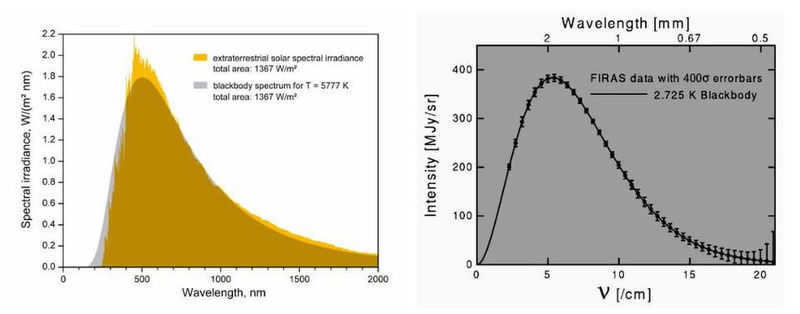
Actual sunlight (left, yellow curve) and a completely dark object (gray). Because of the thickness of the Sun’s photosphere, it is more closely related to dark objects. On the right is the actual relic emission, which coincides with the emission of a dark object, based on measurements from the COBE satellite. It is worth noting that the error range on the graph on the right is surprisingly small (around 400 sigma). The agreement between theory and practice is of historic significance.
Furthermore, our understanding extends to how the radiation’s energy fluctuates as the universe expands. The energy of a photon is directly related to its wavelength. As the universe shrinks to half its size, the remaining photons from the Big Bang possess twice the energy. Similarly, when the universe contracts to only 10% of its current size, the energy of these photons increases tenfold.
Exploring the past when the Universe was a mere 0.092% of its present size reveals a scorching environment that was 1089 times hotter compared to the present state, measuring approximately 3000 K. Such extreme temperatures have the power to ionize all the atoms within the Universe. Consequently, instead of existing as solids, liquids, or gases, all matter in the Universe existed as ionized plasma.
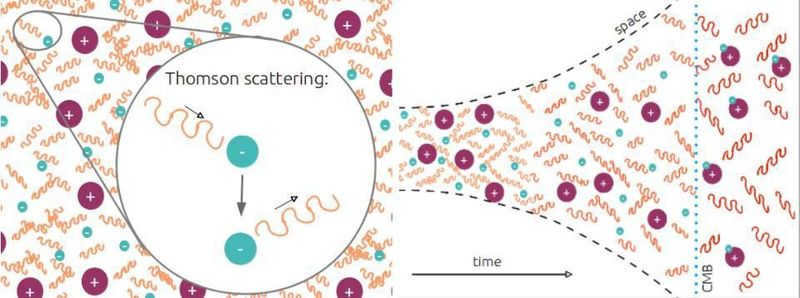
As the Universe cools and expands, the collision between free electrons and protons with photons causes it to become neutral and transparent to photons. The image on the left depicts the ionized plasma before the emission of relic radiation, while the image on the right represents the neutral universe that is transparent to photons.
Three fundamental inquiries
To determine the magnitude of the present Universe, we tackle three interconnected inquiries:
- What is the current rate at which the Universe is expanding? This can be measured through various methods.
- What is the current temperature of the Universe? This can be determined by studying the relic radiation.
- What is the composition of the Universe? This includes matter, radiation, neutrinos, antimatter, dark matter, dark energy, and so on.
By analyzing the present condition of the Universe, we can extrapolate back to the early stages of the hot Big Bang and ascertain the age and dimensions of the Universe.
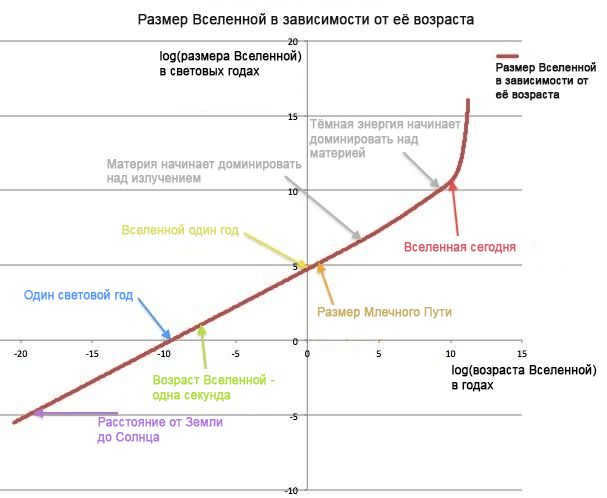
The relationship between the size of the observable Universe, measured in light-years, and the time that has elapsed since the Big Bang can be visualized on a logarithmic plot. It is important to note that this information only pertains to the observable Universe.
By examining various sources of data, such as relic radiation, supernova observations, and studies of large-scale structures and acoustic baryonic oscillations, we can construct a comprehensive understanding of our Universe.
After 13.8 billion years since the Big Bang, the observable Universe has a radius of 46.1 billion light years. Beyond this limit, even if an object were to travel at the speed of light since the initial hot Big Bang, there would not be enough time for it to reach us.
As time progresses, the age and size of the Universe continue to expand, but there will always be a maximum limit to our observational capabilities.
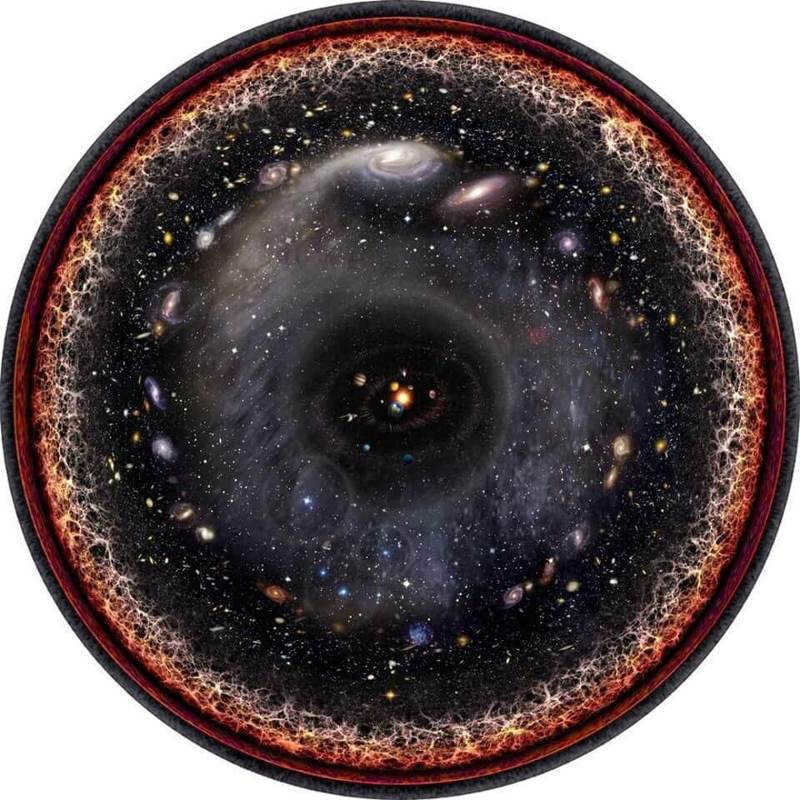
An artistic representation of the unobservable universe’s size is what we see in this logarithmic scale image. It’s important to note that our ability to see into the past is limited by the time that has passed since the hot Big Bang, which is 13.8 billion years or 46 billion light years when accounting for the universe’s expansion. Regardless of where you are in the Universe, you will see a very similar picture.
What lies beyond?
What can be said about the portion of the Universe that exists beyond our observations? We can only make educated guesses based on the principles of physics and the measurements we can make in our observable region.
One example is the observation that the Universe appears to be flat on a large scale, meaning it is neither positively nor negatively curved, with a precision of 0.25%. If we assume that our laws of physics are accurately formulated, we can make an estimate of the size of the Universe before it eventually collapses in on itself.
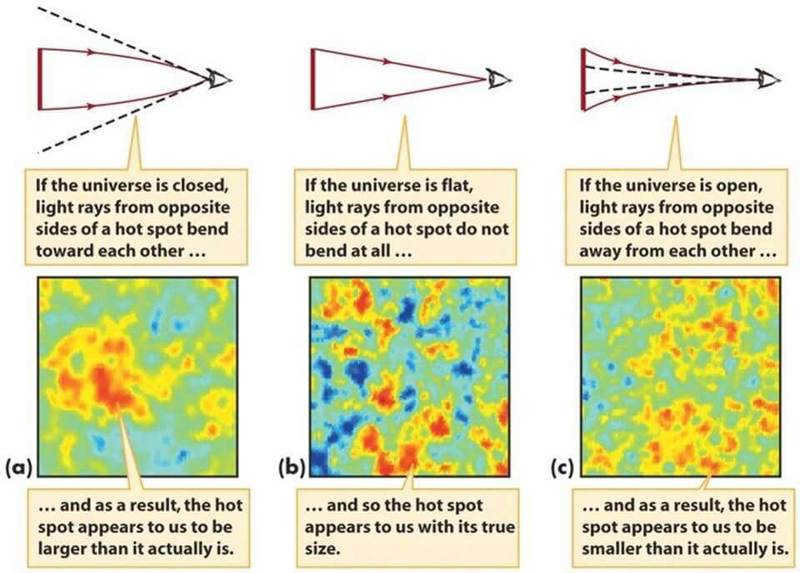
By analyzing the sizes and scales of the hot and cold spots, we can gain insight into the curvature of the Universe. Based on our accurate measurements, it appears to be perfectly flat. Another method for determining curvature is through acoustic baryonic oscillations, which yield similar results.
The most reliable data comes from the Sloan Digital Sky Survey and the Planck satellite. According to this data, if the Universe is curved and closing in on itself, the observable part is virtually indistinguishable from the flat part. In fact, the radius of the curved part must be at least 250 times larger than the radius of the observed portion.
This indicates that if there are no topological abnormalities, the unobserved Universe must have a diameter of at minimum 23 trillion light-years and a volume that is at least 15 million times greater than our observable Universe.
However, if we engage in theoretical reasoning, we can make a strong case that the size of the unobservable Universe must surpass even these calculations.
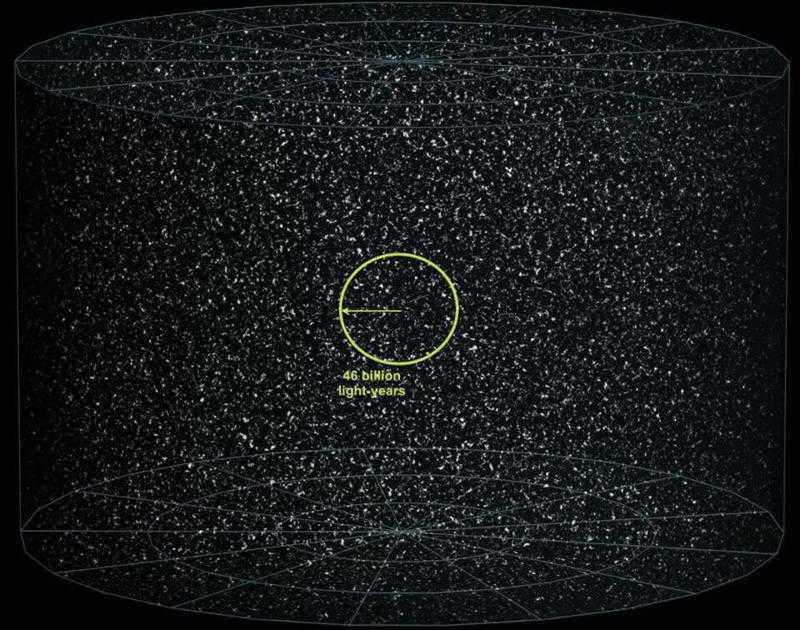
The size of the entire unobservable Universe may surpass the observable Universe, which is estimated to be 46 billion light years in all directions from our vantage point. It is possible that the unobservable Universe extends infinitely, resembling what we are able to perceive. As time progresses, our ability to observe more of the unobservable Universe may improve, although complete observation may never be attainable.
The hot Big Bang event signifies the formation of the observable universe that we are familiar with, but it does not indicate the origin of space and time itself. Prior to the Big Bang, the Universe experienced a period of cosmic inflation. During this time:
- the Universe was filled with the inherent energy of space,
- it underwent exponential expansion at a consistent rate,
- Inflation leads to an exponential expansion of space, which can rapidly result in the flattening of curved or non-smooth space. In the case that the universe is curved, the radius of its curvature must be significantly larger than what we are able to observe.
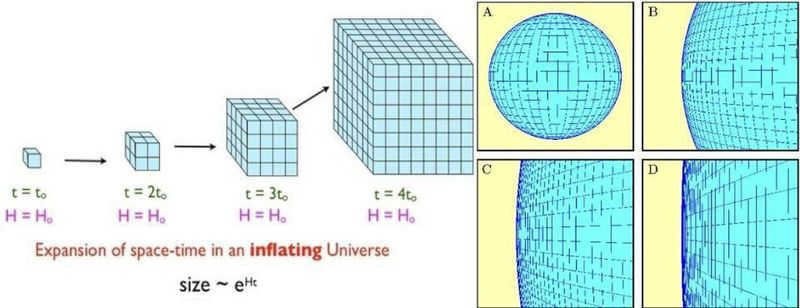
Within our sector of the cosmos, the process of inflation has indeed reached its conclusion. However, there are three crucial inquiries that remain unanswered, and their resolution holds significant implications for the actual dimensions of the universe, as well as its potential infinitude:
- What is the extent of the region within the universe, subsequent to inflation, that gave rise to our Big Bang?
- Is the concept of eternal inflation, wherein the universe perpetually expands, at least in certain areas, a veritable reality?
- How long did the period of inflation persist before ceasing and giving way to the explosive birth of the hot Big Bang?
There is a potential for the region of the Universe undergoing inflation to have expanded to a size close to what we are currently able to observe. It is also possible that there could be detectable evidence of a boundary where inflation came to an end. However, it is equally possible that the universe is significantly larger than our current observations suggest, potentially by a factor of googols. Until these questions are addressed, the central inquiry remains unanswered.

The vast array of distinct regions where the Big Bang occurred are separated by an expanding space due to perpetual inflation. However, we lack the means to test, measure, or access what exists beyond our observable universe.
There is likely a larger Universe similar to ours, with the same laws of physics, cosmic structures, and potential for complex life, extending beyond our visible range.
Additionally, a “bubble” that reaches the end of inflation must have a finite size, as a significantly large number of such bubbles are encompassed within a larger, expanding spacetime.
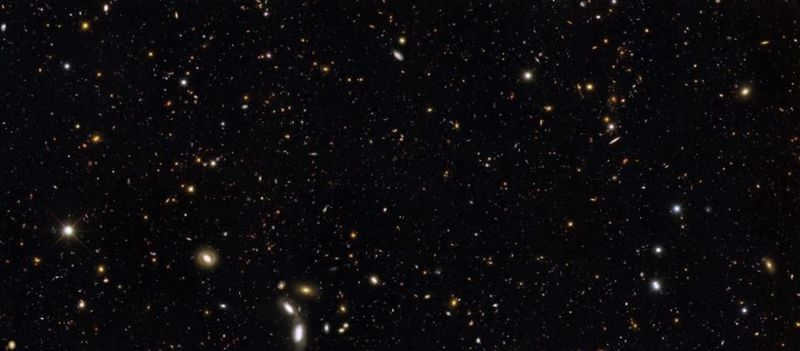
Regardless of the size of the portion of the observable universe we examine and the extent of our vision, it constitutes only a minor fraction of the vast expanse that exists beyond.
The primary obstacle lies in the lack of sufficient information to provide a definitive answer. Our knowledge is limited to the information accessible within our observable universe, which spans 46 billion light years in all directions.
The solution to the ultimate question regarding the finite or infinite nature of the universe may lie within the universe itself. However, our understanding is insufficient to ascertain it with certainty. Until we decipher this mystery or devise a clever strategy to push the boundaries of physics, we must rely on probabilities alone.
Published by econet.ru If you have any inquiries regarding this subject, feel free to ask our team of experts and fellow readers here.
Did you enjoy reading the article? Share your thoughts in the comments section.
Recent scientific research provides intriguing indications that the Universe is not infinite and, furthermore, it has a definite shape.
Such statements are reminiscent of those groundbreaking ideas that fundamentally alter our perspective on our position in this world. One such paradigm shift occurred in 1543 when Nicolaus Copernicus demonstrated that the Earth is not the center of the Universe. In the 1920s, Edwin Hubble observed that galaxies in the Universe were moving away from one another, leading to the concept that our Universe has not existed indefinitely but was generated by a specific event – the Big Bang. Now, we stand on the brink of a new revelation. If the boundaries of the Universe are discovered, we are faced with a new and even more perplexing question: what lies beyond those limits?
Guided by the stars
The vastness of the Universe suggests that it must be boundless not only in terms of its spatial expanse, but also in its temporal duration, and thus possess an infinite multitude of stars. In such a scenario, our celestial canopy would be adorned with countless luminaries, casting a perpetual brilliance. However, the darkness that pervades the heavens serves as a testament to the fact that the cosmos has not endured for eternity. According to the prevailing hypothesis, it all commenced with the event known as the Big Bang, which provided the very foundation for the existence and expansion of matter. This notion in itself refutes the notion of the Universe’s everlastingness, thereby undermining the belief in its boundlessness. Simultaneously, the Big Bang theory presents certain challenges for astronomers as they strive to ascertain the confines of our cosmic expanse.
“The reality is that when it comes to traveling long distances, it takes light years, and as a result, scientists always receive outdated information. The distance that light has traveled in the early universe has increased due to its subsequent expansion. The stars that are closest to us are relatively young, while distant objects can be counted in thousands of years, and if we were to observe other galaxies, it would be in billions. Additionally, we are not able to see all galaxies. The maximum time frame available to us is 13.7 billion years,” explains Neil Cornish, an astrophysicist at Montana State University. A sort of limitation to our understanding is relic radiation, which formed approximately 380,000 years after the Big Bang, when the Universe expanded and cooled enough to generate atoms. This radiation resembles a child’s drawing of the cosmos from before the existence of stars. Beyond this radiation, there could potentially be both boundaries and an infinitely expanding universe. However, despite the capabilities of telescopes, this region remains invisible.”
Cosmic melodies
Relic radiation hinders scientists from peering into the utmost corners of the universe, but, at the same time, it carries a treasure trove of information in the form of microwave background. Scientists speculate that if the universe had no bounds, it would encompass all possible wavelengths. However, the actual wave spectrum of the cosmos is remarkably narrow: the exceedingly long wavelengths that NASA’s WMAP instrument, designed to investigate relic radiation, has never detected. “The universe possesses the qualities of a musical instrument, wherein wavelengths cannot surpass its length. We came to realize that the universe does not resonate with long wavelengths, which serves as proof of its finitude,” explains Jean Pierre Luminet of the Paris Observatory in France.
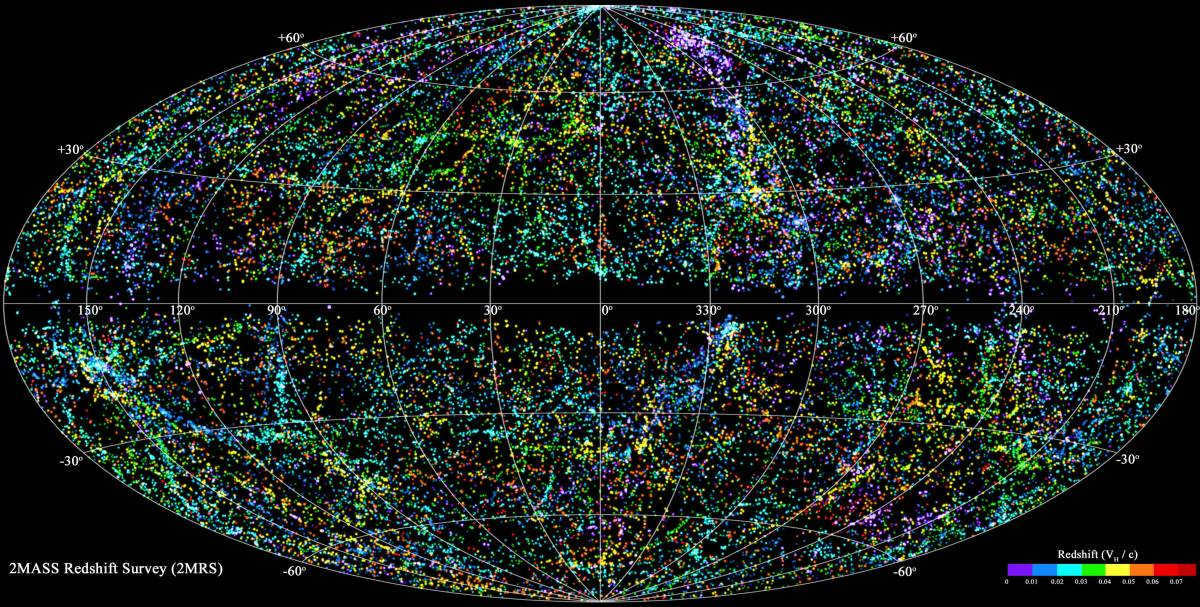
The boundaries and shape of the universe can be determined by Glen Starkmann, a Canadian physicist at Case Western University in Cleveland. He has developed a method to determine the boundaries of the universe, even if they are beyond our current observable range. This method involves using waves. According to Glen, “The sound waves that traveled through the universe in its early stages can provide valuable information. The shape of the universe, similar to a drum, influences the types of vibrations that occur within it.” Glen and his team aim to apply spectral analysis to the universe in order to determine its shape based on the sounds it emits. However, this research is a long-term project that may take several years to yield conclusive results.
Nonetheless, there remains a slim opportunity to acknowledge these boundaries – one must observe the behavior of light. Allow us to envision the Universe as a chamber, with you at its core armed with a flashlight. The light emitted from this source will ultimately reach the wall positioned behind you, then ricochet off the opposing wall, enabling you to witness your own reflection. These same principles may apply within a confined space. “Light portraits” can be reflected off hypothetical space walls, thereby generating numerous duplicates, albeit with some adjustments. If the Universe were marginally larger than Earth, light would swiftly traverse around it, resulting in distorted images of the planet manifesting across the entire celestial expanse. However, the cosmos is so immense that it would require billions of years for light to circumnavigate it and produce such a reflection.
However, let’s return to the topic of bagels. Jeanne Levin’s bagel-shaped theory of the universe has received backing from Frank Steiner, a researcher from the University of Ulm in Germany. After analyzing data gathered from WMAP, Steiner and his team have deduced that the universe is most likely in the shape of a doughnut. Interestingly, their research also suggests that the universe could potentially span a massive 56 billion light-years in diameter.
…or in a football?
Jean Pierre Luminet, despite his admiration for Ms. Levin’s bagel, firmly believes that the Universe takes the form of a spherical dodecahedron or, in simpler terms, a soccer ball: twelve rounded pentagonal surfaces arranged symmetrically. In truth, the theories proposed by the French scientist do not directly contradict the scientific findings of Jeanne Levin and her “Asteroids” game. The same underlying principle applies in both cases – by traversing one side, you ultimately arrive at the opposite side. For instance, if one were to travel on a “superfast” rocket in a straight trajectory, it would eventually lead back to the initial point of departure. Jean-Pierre does not discount the concept of mirror reflections. He firmly believes that with an immensely powerful telescope, it would be possible to observe the same objects in different regions of space, albeit at varying stages of their existence. However, due to the vast distances spanning billions of light years between the edges of a dodecahedron, even the most astute astronomers would struggle to discern faint reflections upon them.
Inflation at a cosmic scale
The initial moment of the universe’s existence has had a significant impact on its subsequent development. Researchers continue to speculate on the concept of inflation – a brief period, lasting less than a second, in which the universe underwent a massive expansion, increasing in size by a trillionfold. The prevailing belief among scientists is that the universe’s expansion is an ongoing process. In fact, the notion of an infinite space can be seen as a natural extension of the inflation theory.
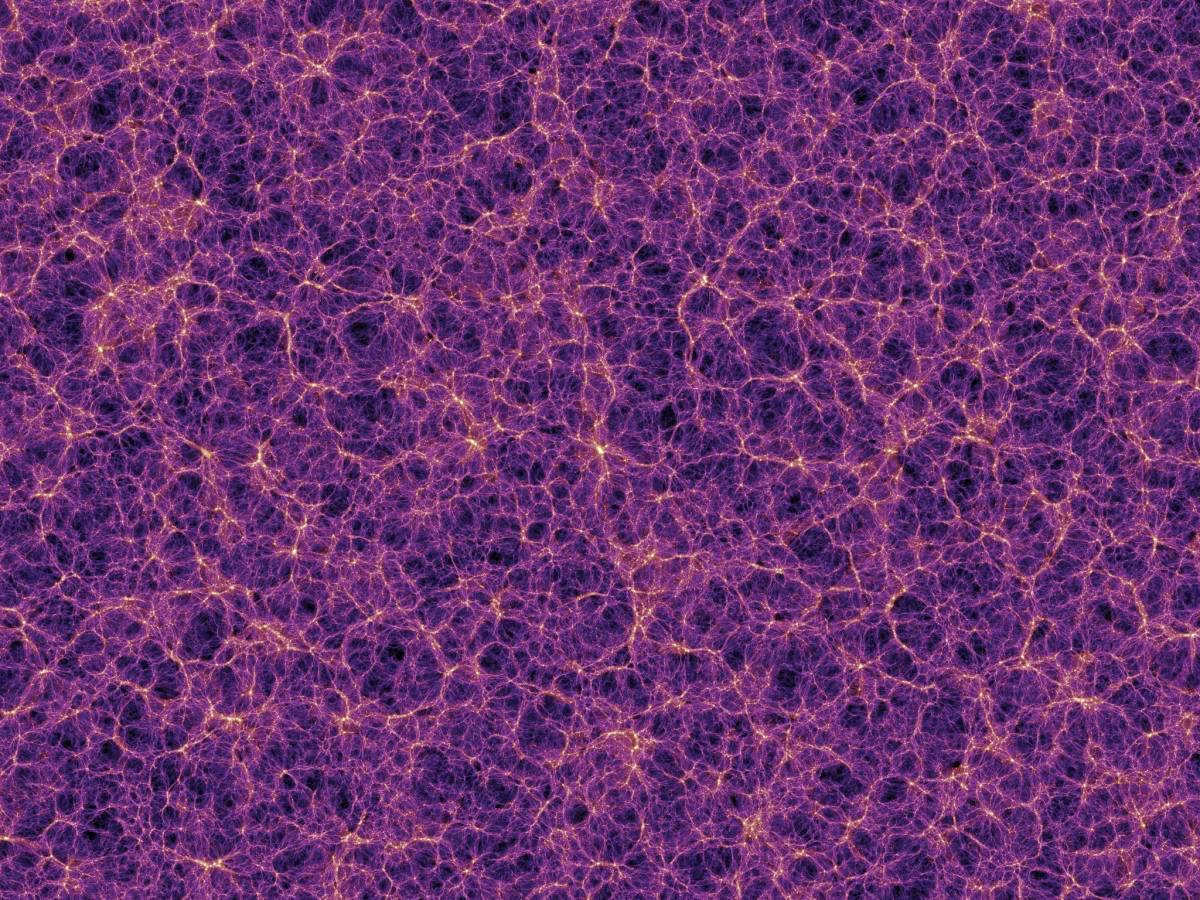
A simulation of the cosmos
However, Andy Olbracht, a theoretical physicist at the University of California at Davis, holds a distinct perspective on this issue: while the ongoing expansion of the Universe endures, there are limitations to this process. Andy has chosen the analogy of a soap bubble to illustrate his theory about the Universe. The conventional inflation theory posits that the bubble will infinitely continue growing, but even young children understand that eventually the bubble must pop. Andy posits that once inflation reaches its maximum point, it must cease. Furthermore, this maximum point is not as extensive as commonly believed. According to Olbracht, the universe is merely 20% larger than the observable space. “Naturally, transitioning from infinity to such a minuscule size – just 20% larger! – is incredibly challenging. It even made me feel claustrophobic,” the scientist jests. Of course, Olbracht’s conclusions are highly controversial and necessitate empirical verification, and currently, the majority of astronomers anticipate that inflation will quickly diminish.
Dark flow and alternative universes
The expansion of the universe is the most plausible explanation for the movement of galaxies in our observable area. However, there are some perplexing aspects to this galactic motion. A team of NASA experts, led by astrophysicist Alexander Kashlinsky, has discovered a phenomenon known as “dark flow” while studying microwave and X-ray radiation. This phenomenon involves approximately eight hundred distant galactic clusters moving cohesively in one direction, at a staggering speed of one thousand kilometers per second, as if they are being attracted by a magnetic force. Remarkably, this universal motion now encompasses 1,400 galaxies and is directed towards a region over three billion light years away from Earth. Scientists hypothesize that there may be an immense mass beyond our observational reach, exerting a gravitational pull on matter. However, this theory conflicts with the current understanding that matter was distributed relatively evenly after the Big Bang, ruling out the existence of such highly concentrated masses. So, what lies beyond our limits?
In her explanation of the existence of multiple universes, Hooftan employs the concept of probability. She posits that the genesis of our own world is a miraculous occurrence, as it could have very well never manifested: the odds of its emergence are infinitesimal, amounting to a mere 1 in 10^133.
“The possibility of the origin of the universe can be questioned when there are multiple structures in which it is formed. These structures are like favorable places where the conditions are suitable for the universe to originate. In simpler terms, we can consider the existence of multiple Big Bangs and multiple universes,” explains Hoftan. To make it easier to understand, she compares these favorable places to hotel rooms. A universe can only come into existence in an empty “room” and exist there alone. However, this doesn’t mean that another cosmos cannot enter the “room” through the wall. But if our Universe is like a hotel room, should we be able to hear our neighbors? In 2007, the WMAP device detected an unusual region with significantly reduced background relic radiation, indicating the absence of matter in that area. According to the scientist, the only explanation for such a cold and absolute void is the presence of other forces at work, possibly another Universe with a massive mass that attracts neighboring matter. And even though these “alien” entities are beyond our vision, our neighbor still makes its presence known through signals in the form of a cold spot and a stream of galactic clusters.”
Undoubtedly, the response within the scientific community to the findings regarding multiple universes is mixed. Nevertheless, researchers endeavoring to delineate the vast expanse of outer space are poised to instigate groundbreaking advancements in the realm of science. The universe we once believed to be boundless may no longer retain that status and instead assume its rightful position in the cosmos, alongside an incomprehensible multitude of alternate universes.
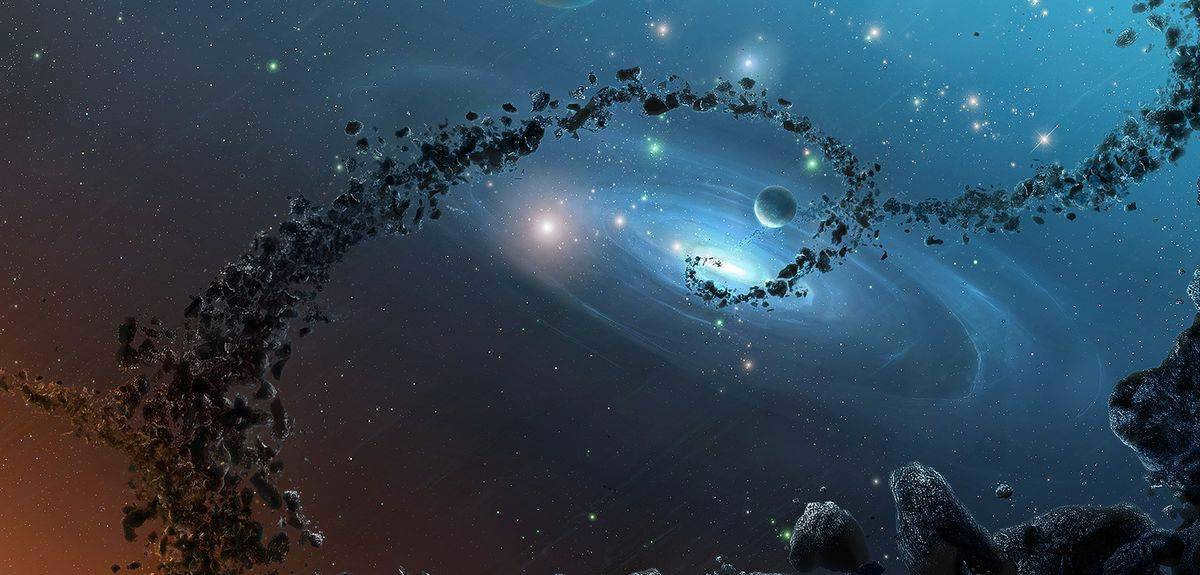
What is the true magnitude of the cosmos and why is it so immense? Nowadays, it’s challenging to come across a scientific publication or newspaper that doesn’t discuss the vastness of our Universe. The realm of scientific knowledge regarding the cosmos continues to expand incessantly. We acquire this understanding primarily through contemporary tools like the Hubble telescope, novel instruments, and an improved comprehension of previously obtained information. An increasing number of observations are substantiating the notion that the universe is accelerating in its movement, that there exists matter/energy beyond our sensory perception that exerts a significant influence on the universe, and that its magnitude far exceeds what anyone could have envisioned in the 20th century.
We are aware that Pluto possesses three moons, and these celestial bodies constitute only a small fraction of the extensive array of objects revolving around the sun. Our ability to witness stars detonating millions of light-years away and observe galaxies undergoing transformations in space has advanced. Within our own galaxy, we continue to perceive the aftermath of Supernova 1987A, a stellar explosion that occurred 160,000 light years distant from our location and which we had the opportunity to witness in 1987.
Various explanations have been proposed to account for these discoveries and the immense distances and dimensions involved. Some individuals choose to outright reject all the evidence. They do so because the new information contradicts their existing belief system, therefore rendering it invalid. These individuals are convinced that this wealth of information and data serves as a larger scheme aimed at dismantling their belief system, with the data itself being nothing more than falsehoods concocted by dishonest individuals.
One way to distort the scientific explanation is by attempting to demonstrate that the apparent sizes and distances are not truly as they seem. Gerald Shroeder, for instance, utilized the concept of relativity in his efforts to clarify the immense sizes. There are also individuals who argue that the speed of light has undergone changes throughout time and is currently undergoing changes. Naturally, there are also those who propose that the curved nature of space is responsible for the perception of large objects and distances. An analogy would be continuously walking around the equator of our planet as we orbit it repeatedly.
The issue is that all these efforts to elucidate the magnitude of the cosmos are highly contradictory to the actual facts and evidence. Most young individuals will comprehend the concepts that will be discussed in this article, and they will also be easily persuaded that the aforementioned explanations lack any factual basis.
Approaches to gauging distances in the Universe
It is crucial to acknowledge that there are numerous techniques for measuring distances in outer space, and all of them indicate the immense scale of the universe. Many of us possess a basic understanding of trigonometry, even if we have never formally studied it. It is a branch of mathematics that aids in the measurement of distances using triangles. If you are able to measure the distance between two points and can determine the angles between those points and a third point, then you can also calculate the distance to the third point.
Imagine a triangle with angles A, B, and C, where the distance from A to B is known and we need to determine the distance to C. Our task is to measure angles A and B. With the help of a straightforward formula, we can easily calculate the distance to C. This mathematical concept is frequently applied in determining the structural properties of large objects like bridges and skyscrapers.
Now let’s shift our focus to the realm of the universe. We have information about the Earth’s orbit around the Sun and are interested in determining the distance to a star. To accomplish this, we need to calculate the angle between the Sun and the star when the Earth is at point A, and then calculate the angle between the Sun and the star when the Earth is at point B. Given our knowledge of the distance between the Earth and the Sun, which serves as the base of the triangle, we can employ basic mathematical principles to determine the distance to the star.
This method for measuring distances in space is extremely precise and dependable. However, it does have one limitation – if the distance to the object being measured is exceedingly large, the angle between the sun and the object approaches 90 degrees, rendering measurement impossible. In such instances, alternative methods must be employed.
There is an alternative method for determining distances in space that involves assessing the luminosity of an object and understanding how it varies with distance. Just like how you can gauge the proximity of a car approaching with its headlights on by observing the change in brightness, physics provides an equation to describe this phenomenon. The equation states that brightness is equal to the intensity of light divided by the square of the distance (E=I/x2). For instance, if you were to observe a 100 watt bulb positioned 5 meters away from you, the brightness would be calculated as 100 watts divided by 5 meters squared, resulting in a value of 4. Conversely, if you are aware of the brightness – 4 – and the power of the bulb – 100 W, you can determine the distance, which in this case would be 5 meters (utilizing the inverse formula). If you find this concept too challenging, I recommend enlisting the assistance of your sixth-grade children, as it is a part of their mathematics curriculum.
The interstellar reddening method is the third technique used for measuring distances. As the light source moves closer to the observer, the colors perceived shift towards the blue and violet end of the spectrum. Conversely, as the light source moves farther away, the energy of these colors diminishes. Eventually, the blue and violet colors fade away, causing the light to take on a reddish hue. This phenomenon is known as reddening.
When the sun is directly overhead and its rays reach us without obstruction, the light appears white and intense. However, during sunrise or sunset, when the sun is positioned at a greater distance, the light rays have to traverse a longer path through the atmosphere. As a result, the sky turns red.
When observing celestial objects, it is often noticed that some of them appear very red. This indicates that the light emitted from these objects has had to travel a significant distance through outer space. This method is utilized to calculate distances within the universe.
The method for measuring distances in space based on galactic velocity is the fourth one. By observing the color shift in the light emitted by an object, we can determine its speed in space. This can be compared to standing next to a set of railroad tracks and hearing the sound of a passing train. The peak of the sound occurs when the train is directly in front of you. Similarly, the noise of racing cars reaches its maximum when a car zooms past. In law enforcement, there is a formula used to calculate the speed of cars, which is also applicable to studying trains and measuring the motion of objects in space. As objects in space get farther away, they tend to move faster. The farther an object is in the universe, the greater its velocity. By measuring the velocity of a galaxy in space, we can determine its distance from Earth. Hubble’s law is instrumental in this process, as it states that the velocity of an object is equal to the product of the Hubble constant and the distance from Earth at which the object is located.
In order to understand how distances in space are measured and assess their accuracy, we have provided straightforward explanations of these methods. These methods are typically taught to students during their studies of physics, mathematics, and other related subjects. It is important to note that while these measurement methods may appear simple, they are actually quite complex in practice. Nonetheless, their fundamental concepts are relatively easy to grasp.
Attempts to refute or discredit these measurements are destined to be unsuccessful
There exist various religious and pseudoscientific groups that attempt to bypass these measurement techniques. The conjecture that the velocity of light undergoes changes and that these changes impact all measurements is an inadequate response to the measurements themselves. The velocity of light is easily quantifiable, and the measurements conducted by Michelson and Morley in the 19th century validate that the speed of light remains constant. Therefore, it is not valid to assume that alterations in the speed of light influence the techniques employed to measure distances in space. Equally unconvincing is the proposition that space previously moved at a velocity close to that of light but has now decelerated. Alterations in velocity impact not only time but also mass. Consequently, if objects were to travel at velocities approaching that of light during a time period close to their origin, all of these objects would possess such immense mass that the entire system would inevitably collapse into a singular, colossal black hole. Numerous factual issues arise with this explanation.
What can we learn from the immense distances in the universe?
Why is the universe of such immense size? How does this vastness align with the teachings of the Bible? These inquiries lead us to three significant dilemmas faced by individuals: 1. Their perception of God is limited 2. God’s plans are grand 3. Human customs are myopic.
Many atheists and believers hold a distorted view of God that does not take into account the immense size of the universe or the nature of spiritual existence. If one believes in a God who is bound by human physical limitations, then the concept of the unfathomable vastness of the universe becomes untenable. It is important to remember that God is the creator of time, space, and energy. The book of Genesis clearly states that these fundamental aspects of existence were not brought into being through physical processes. The portrayal of God and His actions in religious texts demonstrates that He operates in ways that are beyond our comprehension. Quantum mechanics further supports this notion by revealing that the laws governing the behavior of minuscule particles like atoms and quarks are distinct from the laws that govern our everyday physical world. Both atheists and believers are at fault for constructing a limited concept of God that fails to accommodate the immense scale of the universe.
God’s intentions are clearly expressed in the Bible in passages like Ephesians 3:8-11, 6:12, Job 1, and chapter 2. The conflict between righteousness and wickedness extends beyond our physical existence. What if this conflict is leading us far beyond the boundaries of our universe? If that is the case, we will never be aware of it during our lifetime. If that is the case, there must be a purpose behind the vast distances in the cosmos, although we will never grasp it in this present life. The power of God is revealed in the grandeur of His creations. In our own lives and on our planet, we witness the fierce battles between good and evil. We may find it hard to imagine that this conflict could exist elsewhere, even beyond our comprehension, but the sheer size of the universe demonstrates that such a reality is possible.
Human beings have a tendency to belittle God and His purposes. Atheists argue that our existence is solely limited to what we can perceive with our senses. However, this argument falls apart when we delve into the issue of the existence of good and evil (as a part of the metaphysical realm). On the other hand, many creationists take an extreme approach, constructing a version of our existence that is so far-fetched that it requires us to reject not only common sense but also all empirical evidence in favor of religious doctrine. The Bible avoids these pitfalls by presenting human existence in a realistic and comprehensible manner, allowing the phenomena we observe in the universe to align with our personal experiences and understanding.





